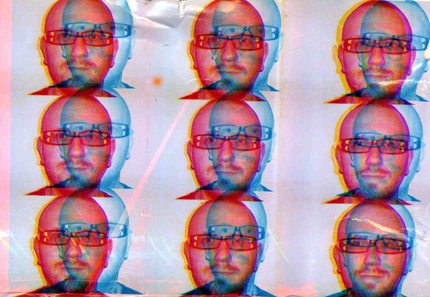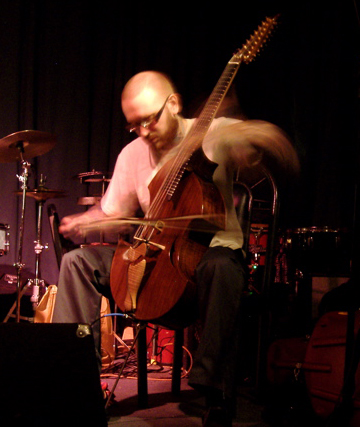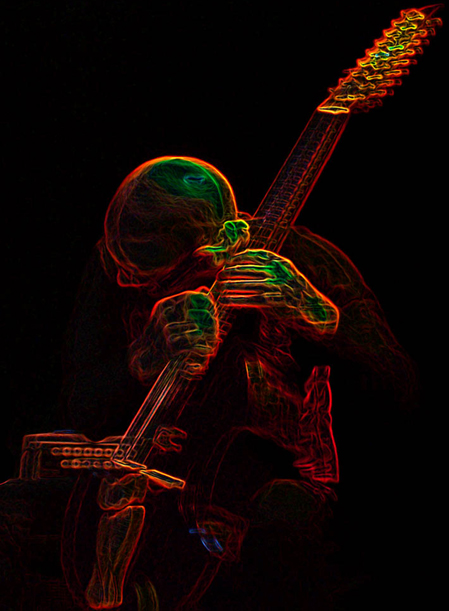
Delene Porter
The H'arpeggione
Killick (formerly Erik Hinds) has been a commanding, challenging presence in the music scene of Athens, Georgia since the late 1990's, via his Solponticello Records, as a show promoter, and as an acclaimed music artist himself. In 2004, he organized the Athens Creative Media Encounter, which brought a remarkable line-up of Free Jazz and Improvised artists, including Peter Brötzmann, Joe Maneri, Ken Vandermark, and Joe McPhee, to a city most of them had never set foot in. However, Killick is a rare improvising musician whose work one would not ultimately define by such categories as Jazz or even "experimental." Surely, the choice to cover Slayer's Reign in Blood [2006] in its entirety distinguished him. But for many, it is the instrument which rendered that version, the H'arpeggione, that marks Killick out as a unique artist. He plays this hand-crafted "devil cello" (though as we will learn below, it is not a cello at all) on nearly all of his records, whether they present solo performances or a diverse array of ensembles, including recently Zepubicle, with guitarists Marshall Marrotte and Jeff McLeod, and The Shaking Ray Levis, of whom Killick is an occasional guest-member. Zepubicle's record also features percussionist Tatsuya Nakatani, perhaps Killick's exemplary collaborator. Whether as a duo or merely engaging in joint performances of their solo work, Killick and Nakatani summon forth sounds that leave the spectator—suddenly, baffingly—uncertain of the relationship between the instrument and what he hears: a mastery of instrumental technique leading toward a transcendence of the divide between musician and musical instrument. Appropriately then, we turn to Killick to launch our Homemade-Instrument-alist section, wherein artists discuss the development and implications of their work with instruments newly wrought and homemade, either by the artist himself or, as in Killick's case, conceived in collaboration with an instrument builder (Fred Carlson, whose site, Beyond the Trees, definitely warrants a visit.) After reading Killick's essay, also venture forth to his site for information on recordings and upcoming performances.
--
In the fall of 1997, at a guitar builder's shop in Atlanta, I happened across American Lutherie magazine, issue 51. The cover caught my attention. I obliged the situation, nodding and complimenting in rote as I focused—just barely—on the proprietor's creations. Desperately though, I wanted to grab the magazine, be alone to behold: the cover featured a close-up of what I'd soon recognize as the headstock of a sympitar, a sympathetic-stringed acoustic guitar made by Fred Carlson of Santa Cruz, California. I had to settle for a raincheck: no copies of the magazine were for sale, and in those budding Interweb days information was not instantaneous. I finally got my own copy a spell later, spending hours staring at and—dare I say—loving the beauty and precise elegance of the instrument. All domestic duties and grooming took a back seat. My already-messy beard and hair got messier; dog hair turned my neat carpet into a shagadelic pile. I was hooked on something I hadn't even heard—but rather had felt, intuited.
A hand-written correspondence with Fred began soon thereafter, and to my delight he took me seriously. At first, I was uncertain as to where by obsession would lead, but eventually we came to the concept of the H'arpeggione. The name is a mash-up of the Hardanger fiddle, a sympathetic-stringed violin from Norway, and the arpeggione, a bowed guitar from Italy, both now considered "period" instruments. I wasn't a total stranger to the custom-building process, having had three guitars made for me prior. But this was the first time an instrument was built for me from the ground up. It would have a flat back like a guitar; an arched top like a cello; six played strings and 12 sympathetics; and would be played upright on a spike. At the time, I reasoned I'd like the six-string set-up (not too wide, easy on the wrist) low pitches (Heavy Metal- and Philip Glass-style) and bowability (since I loved the Indian sarangi, the Hardanger fiddle, and other scratchy-sounding instruments). The choice of recycled redwood for the top would enhance the harmonic content, creating lush, complicated overtones.
Sympathetic strings add fantastic sound-generating potential to the H'arpeggione. Sympathetic strings are additional strings on such instruments as the viola d'amore or sitar that resonate on their own in response to the vibrations of the main, played strings. The sympathetic response is strongest with unison or octave pitches, though 4ths and 5ths do well too. Sympathetic response is heightened by means of a "buzzing" bridge, where the strings lightly touch a piece of wood over the length of an inch or so, right before the anchor point. The resultant sympathetic-string bouncing creates the characteristic "meeowhm" sound. Essentially, any pitch will get the sympathetics going, creating a mild, quiet reverb in addition to the buzz. Sympathetic-string response is strongest when the played strings and the sympathetics are parallel to each other, as on the H'arpeggione. There are physical reasons for this aspect; for the most part though, the art of sympathetics is steeped in mystery, fitting given its ethereal purr. As a solo performer, the sympathetics create a pleasant call-and-response dynamic—on their own, when they want. They do what they do magically, beautifully.

Polly Moller
Fred Carlson, it should be said, is one of the most amazing persons I've met. He grew up in Vermont on a hippie commune, and mastered instrument building there, approaching it from a traditional luthiery, as well as an artistic/sculptural, perspective. Fred's openness and knowledge of many skills is incredible. He possesses a rare combination of creative whimsy coupled with razor-sharp discipline and scientific accuracy. He's a gentle soul, always striving for a deeper understanding of things. It is no exaggeration to say his influence in my life is monumental, and that he has made me, I hope, a better person. He's very private, and lives a quiet life with his partner Suzy in the hills north of Santa Cruz—a beautiful place.
After more than year of back-and-forth, Fred commenced to making the H'arp a reality. I waited semi-patiently, and eventually flew to Santa Cruz around the turn of 2000 to meet for the first time, in Fred's kind assessment, "our baby." At first, I felt a sense of awe, and something akin to love. But it was new love: exciting and a bit overwhelming. I knew I had to nurture this creation and discover what it had to offer.
Easier said than done. Probably the biggest challenge was figuring out the function, the "role," of the instrument. Was it a bass? Was it a guitar? Was it something entirely unknown? The answer, I've come to realize, is yes and/or no! It has required creating an entirely new approach and vocabulary to express my musical language. I don't play it like I would a guitar or bass or cello. I have some techniques informed by playing those standard instruments, but overall I started from scratch. Though I refer to the H'arpeggione as the "devil cello," for the most part it is a cello only visually speaking; and the headstock looks like a devil's tail, or a flame. Because of the H'arp's frets, I tend to avoid playing in the standard manner of the cellist: that of approximating a melodious, vocal quality. Of course, I can create sounds, and patterns of sounds, resembling speech, dialogue, and song. In fact, the instrument is capable of very human-like utterances, with multiple layers of sound similar to inhalations and exhalations, other sounds that may remind the listener of the human voice, as well as wind. But generally, the H'arp's output remains sonically distinct.
I've created my own pedagogy, one that works in solo and ensemble performance. The trick, I found out, was that the H'arpeggione doesn't play itself! Lots and lots and lots of hours, and I'm still discovering avenues to pursue. In contrast, with traditional instruments, I had thought there was something else out there waiting for me to discover, even if I didn't know what form it would take. In retrospect, I never "connected" with guitar or bass. I love them, but I always felt like I was trying on someone else's clothes. There was a discomfort that seemed to me to be incongruous with my fascination with the sound world. Specifically, I was looking to have an acoustic instrument with a very wide range of pitches and, more important, a very wide array of colors and textures.

Delene Porter
Cerebus features some of my earliest excursions on the H'arpeggione. The album was deliberately a little shaky: raw sketches instead of a polished presentation. I played the H'arp on both S. S. Puft records: an ensemble set-up, allowing me to figure out the space the instrument occupies. In a Jazz framework like so, the H'arp was cast as the bass instrument, with the expectation of using walking bass lines and other hallmarks of the idiom. I started feeling stronger as a player with the Georgian Contemporary Unit (which put the record The View You Never Get) and my C. D. Khonsay: both have solo and group work, and I'm proud of them. Then I did the Slayer cover Reign in Blood: it's totally solo-H'arpeggione, and pushed my physical abilities at the time. There's the Shaking Ray Levis trio album ASAP Wings, during my name change-over from Erik to Killick. Under Killick, there's the Zepubicle disc Scientists Levitate Small Animals. I'm very pleased with both of those records. More recently, I recorded Bull****, a solo record featuring the harp guitar, Big Red, also built by Fred Carlson. My latest H'arpeggione-centric album is called The Amplifucker.
A curious aside... The wood used for the top of the H'arp came from a stand of redwood stumps in Santa Cruz, clear-cut in a previous era. This wood, salvaged from "industrial waste," was harvested and allowed to stabilize through controlled temperature and humidity before it was worked. In an unexpected twist, the stumps have recently begun to grow again! When the H'arpeggione is back in Santa Cruz—there's no other way to describe the it—the instrument is at home.
